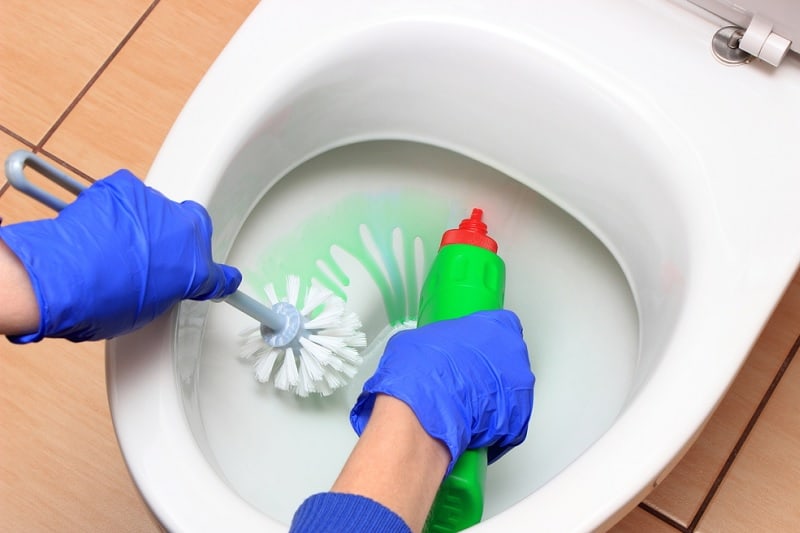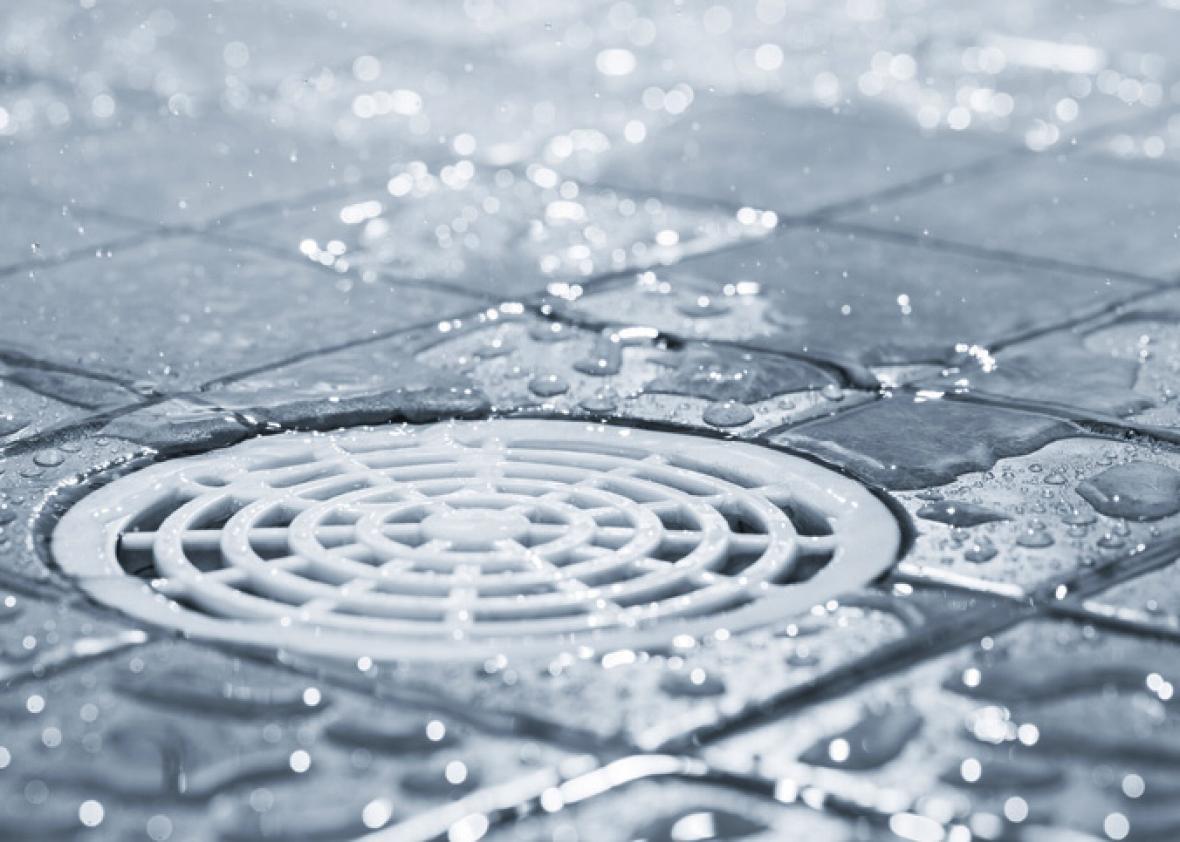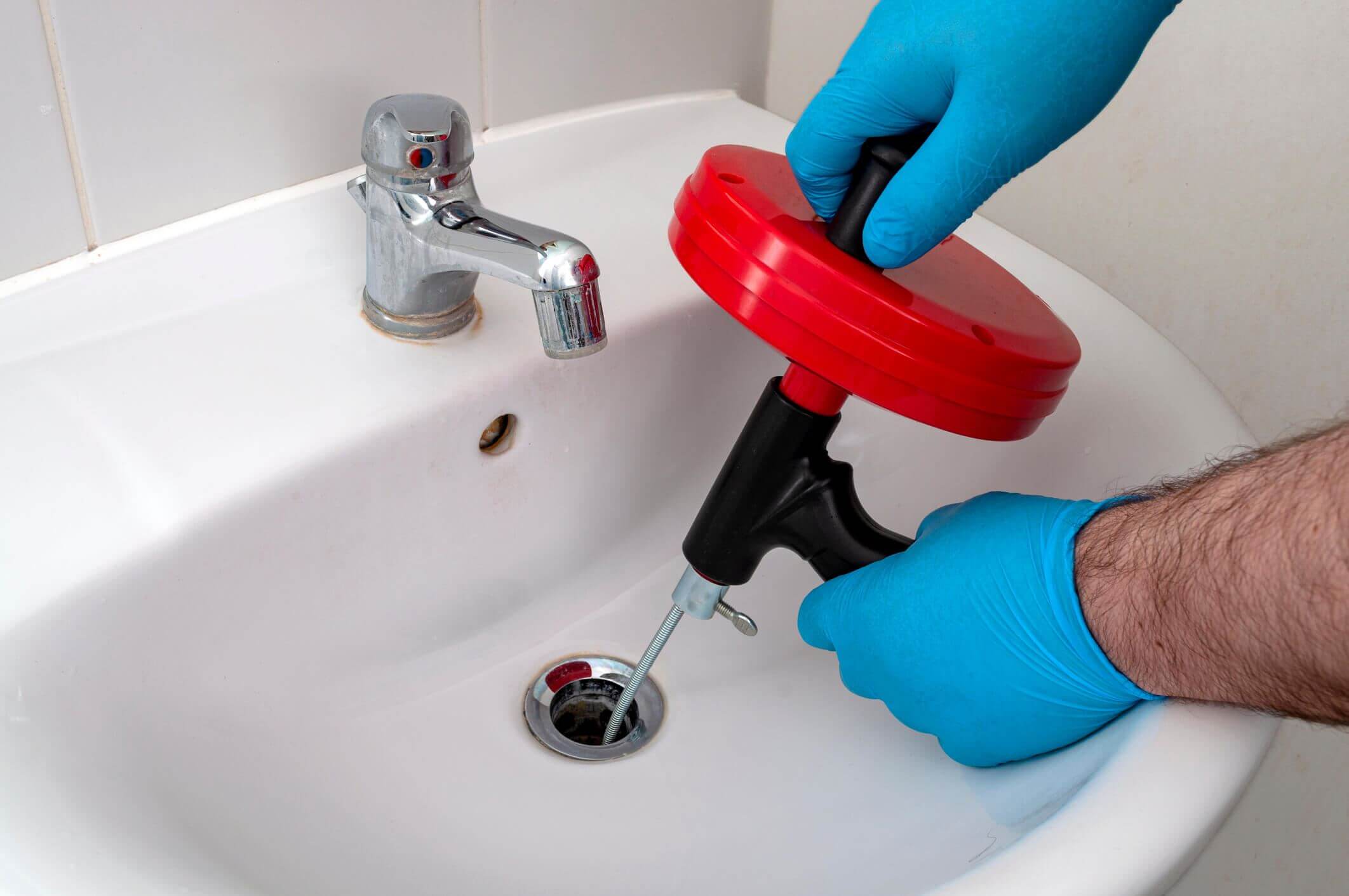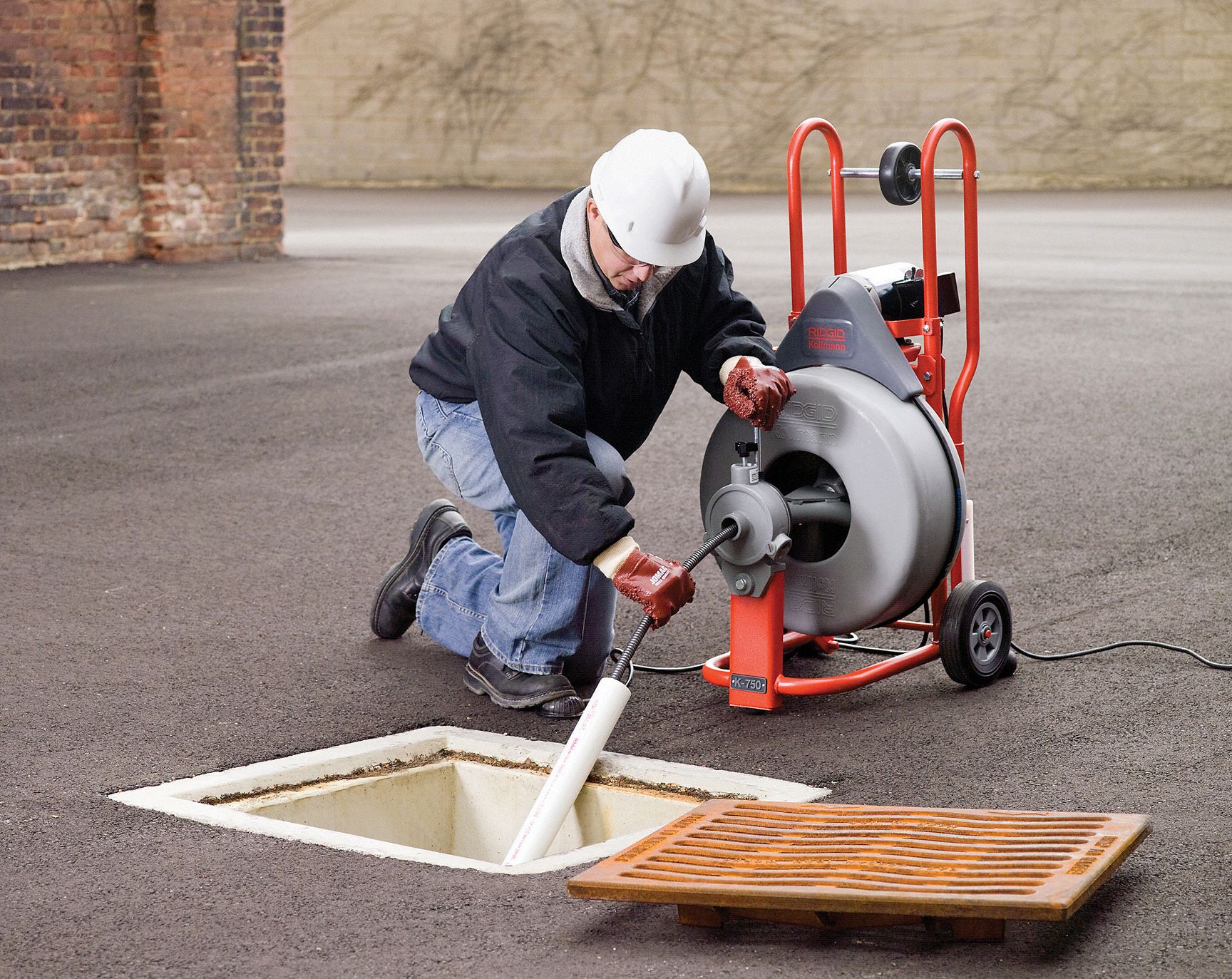Drains can get clogged and slow down your bathroom.
The problem is that most of us don’t know how to use a drain auger, so we end up calling professionals who charge by the hour.
This guide will show you exactly how to unclog drains using a drain auger without breaking the bank.
You’ll learn everything from how to use the drain auger, to what kind of blockage you’re dealing with, alternatives to drain auger, and finally how to clear it out safely!
How Does Drain Auger Work?
A drain auger is a tool used to unblock and clean drains.
It consists of a long flexible metal coil that can be pushed down the drain pipe. The coil has a corkscrew-shaped end that grabs onto the blockage and removes it.

The handle consists of a trigger and crank mechanism. You can crank in the coil manually or use the electric drill to winch in the coil.
- 50 Foot Drain Auger
- Hands-Free Power
- 1/4 diameter snake
- Pipe capacity - 1/2 to 1-1/2
- Cable thickness -1/4
A drain auger is different from a plumber’s snake, which has a rigid target tip that doesn’t move once inserted into a pipe.
A plumber’s snake can clear out build-ups in sewer lines. A drain auger is designed to unblock bathroom sinks, tubs, showers, and kitchen drains.
A drain auger can be very useful when you have a clogged shower or sink drain because it’s flexible enough to pick around obstructions without damaging the pipe walls.
How Do I Know If I Have a Blockage?
While plugging or slow running water are obvious signs that your drain is blocked, there are other signs that you should look out for.
- If you find that your drains are regularly getting blocked despite the use of drain cleaners.
- If you start to notice any material on the sides of the pipes, instead of flowing down and out of the drain.
- A build-up of hair, grease, or food can also lead to a smelly drain.
- If you have a bad smell coming from your drains it could be a sign that there is an organic blockage that is rotting and producing methane gas.
Then this would be a sign that you have a blockage, if this is the case then a drain auger should be used.
What Can I Expect From Using a Drain Auger?
If you are having problems with your drains, such as slow-running water or a build-up of material on the sides of the pipe, it may be time to use a drain auger.
This is an easy process that can be done with or without water, depending on the type of blockage.
It is recommended to use the auger in conjunction with some sort of drain cleaner to help dissolve any build-up, although most household drain cleaners will not be effective on organic blockages.
Using a Drain Auger: A Step-by-Step Guide
You can use a drain auger by hand or with the aid of a power drill.
The best way to use a drain auger is to insert it into the drain and turn the handle until the obstruction is removed.
To use a drain auger, follow these steps:
Safety Equipment
Before using the drain snake, you will need to put on some safety equipment.
This includes safety goggles to protect your eyes and rubber gloves to protect your hands.
Remember to always wear safety goggles when using a drain auger so that you do not get debris in your eyes.
Identify the Clog
The most common type of clog is caused by hair, grease, and dirt buildup.
If you can see the blockage, you can probably remove it with a plunger.
If the clog is further down the pipe, you’ll need to use a drain auger.
Cleaning the Drain
It is important that you first clean out the drain before using the snake because it will be difficult to push through any debris that has already built up inside it.

Start by removing hair, soap scum, and any other blockage that you can reach with your hands.
Use a plunger to try and loosen any large blockages.
Prep
Before using the drain auger, make sure that you have a bucket or some other container to catch the debris that will be dislodged from the drain.
Turn off all water supply valves to prevent flooding.
Remove the cover plate from the drain.
Inserting The Drain Auger
Before inserting the auger, you can use a flashlight to peer down the drain and identify the obstruction if it is visible.
Insert the drain auger into the drainpipe and push it down until you reach the clog.

Twisting & Cranking
Once you have inserted the auger into the drainpipe, twist the handle to rotate the coil.
Turn the crank or drill the handle to the wind in the coil.
If you are using a manual drain auger, you will need to twist the handle to rotate the cable.

If you are using an electric or motorized auger, you need only to turn on the machine for it to do the work.
However, an electric drain auger can be difficult to use. Since it requires you to push the tool further into the drain, you need enough muscle power to do so.
Operating Drain Auger
Be sure to keep the auger perpendicular to the pipe. If you do not keep it in this position, there is a chance that you could damage your drain.
If you have a garbage disposal, be sure not to put too much down it at once as this can cause a clog.
Clearing Obstruction
The auger will start to pull out any material that is blocking the pipe.
If there is a lot of material, it may be necessary to repeat the process a few times.

If the clog is not near the top of the pipe, you may need to insert the drain auger further into the pipe in order to reach it.
Be careful not to kink the cable while you are twisting it. This can damage the tool and make it difficult to use.
Make sure that you hold on to the cable tightly as you are rotating it. This will help prevent it from slipping out of your hands.
Pulling Clog Out
Once the clog is dislodged, pull the auger out of the drain.
If the clog is not coming free, stop turning the handle and try using a plunger to dislodge it.

Once the clog is removed, remove the drain auger and flush the pipe with water to clear out any debris.
Dragging Debris
If the auger is covered in debris, use a gloved hand to remove it.
You can also rinse off the tool with a hose if you prefer. Be sure that the water supply is turned off before doing so.
Rinse your drain with hot water from a sink.
Finally, replace the cover plate to prevent further problems.
Clean your drain often to prevent blockages from occurring.
Now that you know how to use a drain auger, you can easily clean your drain by yourself. While it is a simple device to use, you will need safety equipment and the right technique in order to successfully remove the clog from your drain.
If your drain is still blocked after using a drain auger, call a plumber for professional help immediately.
What if the Drain Auger Doesn’t Work?
A drain auger is an excellent tool, but if not used properly it can cause even more damage.
It is important to read the manufacturer’s instructions carefully before using a drain auger.
If a drain auger doesn’t work, it may be because:
- You’re using the wrong tool. A drain auger is designed to unblock bathroom sinks, tubs, showers, and kitchen drains. It’s not designed to clear sewer lines.
- The clog is too far down the pipe. If the clog is further down the pipe, you’ll need a plumber’s snake.
- You’re using the wrong technique. Sometimes people don’t follow the steps correctly and fail to unclog the drain.
What is the Alternative to the Drain Auger?
If you are not comfortable using a drain auger or would like to try something different, here are some other solutions that may help:
Clean Using Baking Soda and Vinegar
You can dissolve the hair so it is easier to remove by pouring vinegar and baking soda down your drain.
This will start a chemical reaction inside the pipes resulting in a bubbling effect.
Once the reaction has stopped, pour boiling water down the drain to flush it out.

Pour baking soda down the drain until it is one-quarter full. Then pour vinegar on top of the baking soda so that there is a chemical reaction inside the pipes.
The bubbling effect will break up any clogs in your drain. Wait for ten minutes before pouring boiling water down the drain to flush it out.
Use a Garbage Disposal
If you have a garbage disposal, you can use it to help remove clogs.
Simply put some ice cubes and salt into the disposal and turn it on. The ice will help break up the clog and the salt will help clean the pipes.
If you do not own garbage disposal, you can try using the following:
- Use Hot Boiling Water Pour hot boiling water down your drain and wait for several minutes. This will soften any clogs in your drain and make them easier to remove.
- Use a plunger or an auger after pouring the water down the drain.
Use a Plunger
You can use a plunger in order to clear the drain by yourself. It is effective if you are able to unclog the drain quickly and without hassle.
If the clog is not too far down the pipe, you can try to dislodge it by using a plunger.
This will create a suction effect that may be strong enough to break up the clog.
Make sure that you cover the overflow hole to avoid any excess water spilling out. To do this, fill your sink with water and plunge up and down for 5 minutes.
Repeat this step until the blockage is gone.
It should be noted that using a plunger is not as effective as using a drain snake or auger and it will not work if the clog is too far down the pipe.
Clean the Drain with a Snake
Another option is to use a drain snake as it will help remove any hair or other debris from inside your pipe.
This can be done by dropping the tip of the snake into the drain and winding it around in a circular motion.
You can also use a plunger at the same time to help loosen any large clogs.
Use a Chemical Drain Cleaner
If the clog is not too stubborn, you can try using a chemical drain cleaner.
These cleaners come in liquid or tablet form and work by dissolving the blockage.

If you want to use a chemical drain cleaner, it is best to pour the product down your kitchen sink. This will allow the chemicals to work on the clog before heading down towards your waste pipes.
Once it has finished dissolving, flush the drain with boiling water and then cold water for 10 minutes each.
However, it is important to read the instructions carefully as these products can be harmful if used incorrectly. Another downside of using chemical cleaners is that they can damage your pipes over time.
Call a Plumber
While using a drain auger can be effective in removing clogs, you may still need to try other methods if it is not working.
These include using baking soda and vinegar, a snake, or chemical drain cleaners. If you are still having trouble removing the clog after trying these methods, call a plumber for professional help.

A professional plumber who can safely and efficiently remove the clog. Not only will this get your sink draining again but it will also prevent any future problems with your drain.
How Often Should I Use A Drain Auger?
If you are using a drain auger then it would be wise to use one regularly, as often as once every month.
This will help to avoid any build-up that could result in a blockage. It is possible to clean your drain using just a drain snake, this will not only unblock the clog but also help to prevent it from happening again.
Regularly clearing out your pipes of any debris can reduce the risk of clogs developing over time. If you do not feel comfortable using a drain auger or snake, then it is best to call in a professional to help clear the blockage.









